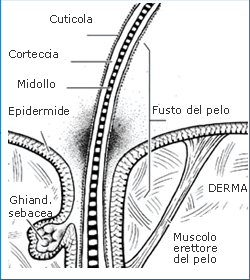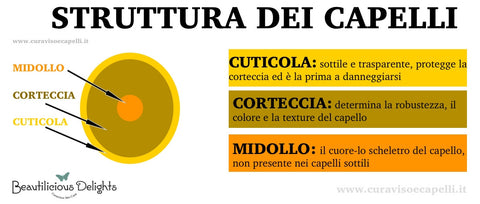In order to be able to give targeted care to our hair it is essential to know the structure of our hair, i.e. to understand HOW and from WHAT hair is made .
A natural cure for your hair will only give results if you choose the remedies well aware of what your hair needs to return healthy and strong.
How could you ever understand which remedy is more suitable without knowing what the hair is like, what is its structure ?

Applying cures and using hearsay remedies and just because they worked for your friend's or your mom's hair? Wish it were that simple! Remember that each hair is unique and has different needs also based on our lifestyle and consequently reacts differently to the various remedies we could try to cure them.
I know, talking about the structure of the hair may seem like a difficult and boring subject but I assure you that once the foray into this fascinating universe is over you will be left with a sense of wonder but above all you will be able to fully understand how our hair is made and how it works and why you should choose one natural remedy over another for your hair.
READ ALSO: Fine and Thin Hair? Here are 4 Essential Habits to Give Volume and Strengthen them!
I'll try to make it as least complicated and as easily memorable as possible. So shall we begin?
How are they made, what is the structure of our hair?
Hair consists of:
 ✓ a hidden part that is located under the scalp, the living part that ensures proper growth, i.e. the root.
✓ a hidden part that is located under the scalp, the living part that ensures proper growth, i.e. the root.
The sebum together with the sweat contribute to the formation of the hydro-lipid film which protects the hair from chemical (aggressive detergents) and bacterial aggressions and in addition they lubricate and waterproof the external surface of the hair as it lengthens. The shaft is lubricated even before the hair appears on the skin surface.
What is the hair shaft like instead?
Speaking strictly of the hair shaft on which, moreover, the aesthetic aspect of our hair depends, we distinguish:
1. The CUTICLE
that is, the outermost part made up of 5-6 protective layers of transparent cells (because they lack pigment), cells formed of hard keratin. These cells are arranged as if they were tiles on a roof. To get a better idea look at the photo below ↓:

When the flakes adhere to the underlying layer, the hair is shiny and healthy. On the other hand, when the hair is dry, brittle, dull and damaged, the "scales" are open, just like the scales of the pine cone that you can see in the photo above ↑ .
Being the outermost part of the hair, the role of the cuticle is to protect the shaft from external, chemical and environmental agents. It is sufficient for the flakes to lift even only partially to make combing difficult. Often even a single bleaching treatment is able to eliminate a good amount of the cells that form the cuticle.
Obviously the cuticle is also the first part of the stem to be damaged by the high temperature of hair dryers, straighteners, curling tongs, aggressive products and/or atmospheric agents.
So based on how damaged or not, the cuticle also defines how soft and shiny our hair is.
READ ALSO: Restructuring Volumizing Pack for Fine, Thin and Damaged Hair
2. The BARK
that is, the intermediate part made up of several layers of hard keratin cells and melanin granules which is the pigment that gives color to our hair and which tends to decrease with age. The cortex is also the part that determines the shape and texture of the hair.
In dark hair, in the heart of the stem, in the medulla and in the cuticle, there is eumelanin - to which we owe the black and dark colors - while in the other types of hair (blonde, red) we find pheomelanin - to which we owe the yellow - only in the outer layer, in the cuticle while we owe the red color to trichochromes .
For example, blond hair contains both eumelanin and pheomelanin while the hair of people of Asian or African descent contains only eumelanin.

When, on the other hand, the cells that produce melanin no longer function properly, the hair turns white.
If the outer part of the cuticle represents approximately 10% of the thickness of the hair structure, the cortex reaches up to 80% . This part is not only the thickest but also the most fibrous because this is where the keratin is concentrated.
When the hair is very fragile to the point of breaking easily and has split ends, the damage suffered by the shaft usually goes well beyond the cuticle to the cortex.
3. The MARROW
i.e. the inner part, the heart of the hair , is made up of very large cells of spongy keratin separated from each other by cushions / air bubbles. These empty spaces present between the cells affect the more or less light / dark shade of our hair. In thin and very fine hair, the marrow is absent while in thicker hair it plays the role of "skeleton" of the stem.
The intensity of the color of our hair therefore depends not only on the melanin pigments and air cushions present in the medulla, but also on the absorption of light and therefore on how healthy or not the hair cuticle is: if the "tiles " are open and raised, the hair reflects much less light so it will also be more opaque and dull.

But now that we understand what the structure of the hair looks like ...
What are the chemical elements that make up hair?
However complex the structure of the hair may be , the basic elements that make it up are actually few.
In addition to water , the other elements that make up the hair structure are:
- essentially keratin: filamentous protein that is concentrated in the bark of the stem, protein composed of 18 amino acids including mainly: cystine (17.5%), serine (11.7%) and glutamic acid (11.1% ), cysteine, arginine, asparagine, proline, glycine, valine, leucine, isoleucine, etc. Keratin makes the hair waterproof and makes the hair structure elastic, resistant and robust.
-
lipids: squalene, fatty acids, triglycerides, waxes, phospholipids, cholesterol - mostly derived from sebum lipids.
- minerals (trace elements) : iron, magnesium, zinc, copper and lead. A curious thing is how the predominance of the minerals present in the stem varies according to the natural color : if magnesium is predominant as a percentage in black hair , in brown hair lead predominates , while in red hair it is iron . Scientific studies attest that there is a real correlation between the quality and quantity of minerals and the state of health of the hair . A zinc deficiency weakens the hair and slows down its growth rate. As a result, often when our hair is particularly fine, thin and brittle it is because we have a mineral deficiency.
- the pigments, insoluble in water, soluble in strong acids, decolorable with hydrogen peroxide.
Remember to subscribe to the YouTube channel for new tutorials -->> SUBSCRIBE
© Beautiful Delights
In the online shop you will find everything you need (including herbal dyes) to take care of your skin and hair in a conscious way. Click HERE to visit it!
************************************************** ************************************
Keep in touch with us:
Follow us on SOCIAL by clicking on the icons below to stay up to date on the latest news:
Rozalia & the Beautilicious Delights Team.



